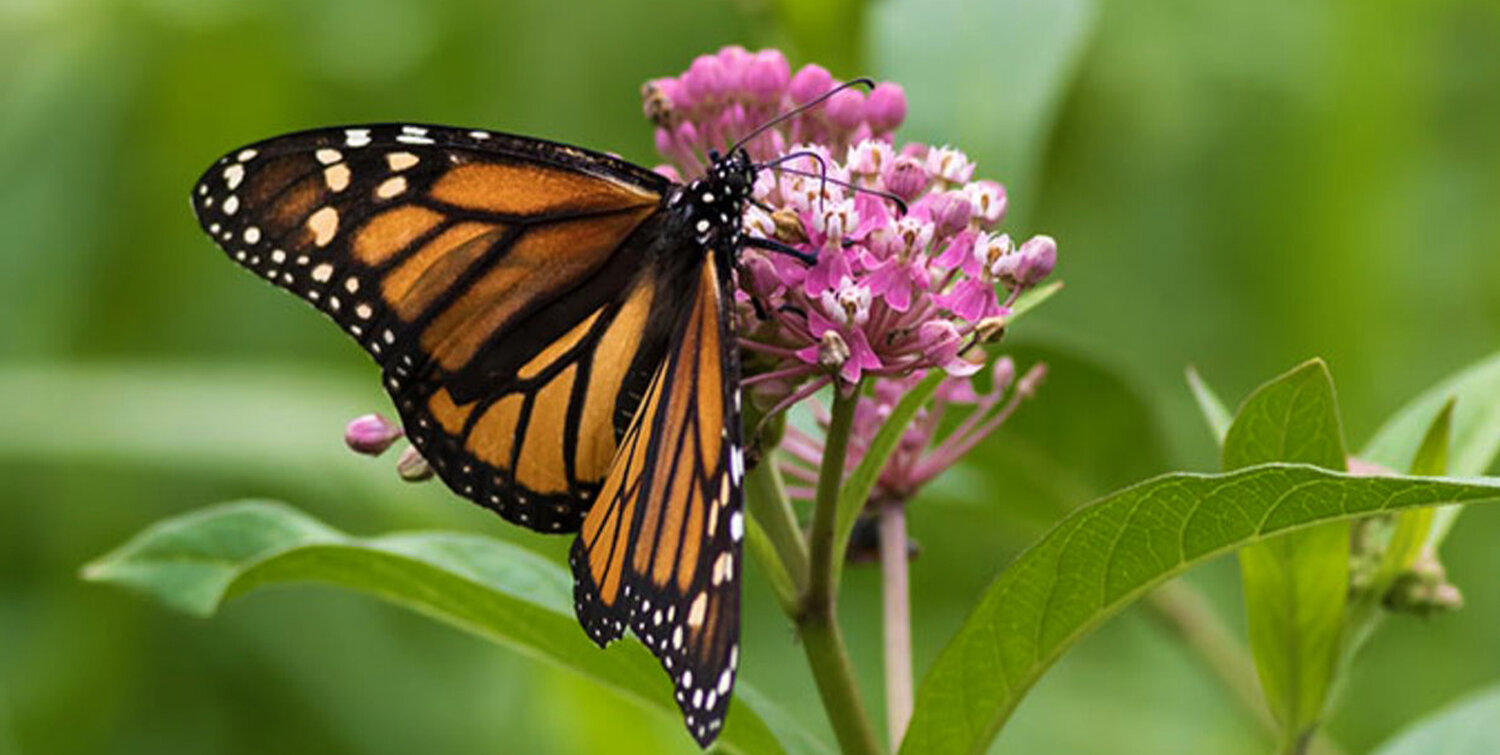Monarch Butterflies & the Super Generation
Monarch Butterflies & the Super Generation
Written by Kristine Manganelli (Somerset County 4-H Coordinator)
Monarch butterfly.
The bugs are back! Insects that have been dormant or away for the winter are reappearing in my yard lately. While many are undesirable, the butterfly is always a welcome visitor. I’ve spotted one or two fluttering by this Spring, early signs of their return to the area. With a prism of colors and a kaleidoscope of patterns on their wings, people are naturally drawn to butterflies. The metamorphosis from chrysalis to butterfly is magical, and symbolizes the change and growth inevitable in life. There are thousands upon thousands of species, but today I will examine the monarch. Monarchs intrigue me as they are both fragile and tough at the same time. Weighing in at under 1 ounce, their paper-thin wings are capable of flying unimaginable distances.
The monarchs found in New Jersey are Eastern monarch butterflies with breeding grounds in the North Eastern United States and Canada. They have a special relationship with the milkweed plant, laying their eggs on the underside of its leaves. In fact, this is the only place female monarchs will lay their eggs, and the only food the newly hatched caterpillars will eat. Milkweed even plays into the monarchs’ defense mechanism. Milkweed is toxic, but monarchs have evolved to tolerate the toxins and store them in their bodies to harm predators. Their bright orange color warns predators like birds that they are poisonous.
Monarch butterfly on milkweed.
In the adult stage, monarchs subsist on flower nectar, and drink it with a long tube-like tongue called a proboscis which coils up when not in use. Adult butterflies have many other unique qualities such as chemoreceptors on their feet, which allow them to “taste” if what they’ve landed on is a food source. A butterfly’s wings are made of layers of protein so thin, they are transparent. The iridescent colors and patterns are caused by reflection of light off thousands of miniscule hairs, or “scales” that cover the wings. Butterflies use muscles to flap their wings in a figure-eight motion, pushing themselves through the air.
Butterfly eyes have 6,000 lenses with photoreceptors that allow them to detect ultraviolet light, a spectrum that humans and animals cannot see. Flower petals have evolved ultraviolet patterns like bull’s eyes, or landing strips that direct butterflies to the center where nectar is located. This is a partnership of mutual benefit, because as the butterfly flits from flower to flower sipping nectar, they are actually performing essential work. Each time they land on a flower, grains of pollen stick to them and are transferred onto the next flower. Playing a vital role in the fertilization cycle, butterflies are one of our most important pollinators.
Monarchs cannot survive the cold winter temperatures, and as fall approaches they are triggered by shorter days and the dying off of nectar sources. Adult monarchs alive at this time become members of the “super generation” because they are the first of at least four generations to journey South. While their parents, grandparents, and great grandparents lived for just five to seven weeks, this generation can live up to eight months. In this time, they complete a somewhat unbelievable 3,000 mile journey to Central Mexico on the most highly evolved migration pattern of any butterfly species.
The monarch migration routes are known as flyways, and the butterflies stop during inclement weather or to rest along the way. One of these stopovers happens every year in Cape May during September and October! It is still not fully understood, but recent studies show that monarchs may navigate using the sun, and rely on an inner magnetic compass during cloudy days. They catch rides on thermal air currents, sometimes flying a mile high in the sky.
Migrating monarchs roosting on tree branch.
When they finally arrive in Mexico, millions of monarchs roost huddled together in semi-dormancy on the branches of Oyamel Fir trees. These conifers found at high altitudes of volcanic mountain peaks offer monarchs protection in the tree canopy while they wait out winter. When the days get longer, the monarchs begin their journey North again, timing their Spring migration with the availability milkweed habitat and nectar supply.
The super generation will stop part way to lay eggs but won’t ever return to the original breeding grounds. In just a few weeks these eggs will hatch into caterpillars, form chrysalises, and emerge as adults that will travel another few hundred miles farther North. This process repeats for up to three generations before the great grandbaby monarch finally reaches the destination where the cycle will begin all over again.
Despite the determination of the monarch, conservation groups have had to petition to add monarchs to the endangered species list, as their population is in severe decline. Monarch populations have dropped up to 90% since the 1980s!
One factor is the decline of milkweed populations. The monarch literally cannot survive without it, so if you want to encourage monarch population growth as well as attract monarchs to your yard, plant milkweed! Other flowers that are beneficial for butterflies are nectar flowers such as Echinacea, Bee Balm, Aster, Lavender, Poppies, Sunflowers, Zinnias and other colorful, or native flowers. Choose flowers with different bloom times throughout the season so our pollinators have a steady source of food.
Refer to the Monarch Watch website to learn what type of Milkweed is native to your area before planting. They even offer free milkweed plants or seeds to promote Monarch Waystation habitats. To learn more visit: http://monarchwatch.org.
SOURCES
The National Wildlife Federation: http://nwf.org
World Wildlife Federation: https://www.worldwildlife.org/species/monarch-butterfly
North American Butterfly Association: https://www.naba.org/
San Diego Zoo: https://animals.sandiegozoo.org/animals/butterfly
National Geographic: https://www.nationalgeographic.com/animals/invertebrates/m/monarch-butterfly/
Yale Environment 360: https://e360.yale.edu/features/to_protect_monarch_butterfly_a_plan_to_save_the_sacred_firs
New Jersey Department of Environmental Protection: https://www.nj.gov/dep/docs/monarch-guide.pdf



